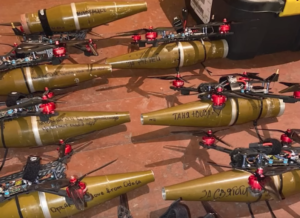Chris Copson of The Tank Museum has an in-depth look at the RPG-7 and its history as an effective hand-held tank-killing weapon and poor man’s artillery.
Some highlights:
Chris Copson of The Tank Museum has an in-depth look at the RPG-7 and its history as an effective hand-held tank-killing weapon and poor man’s artillery.
Some highlights:
I’ve previously covered suicide drones and drones dropping RPGs. Now Ukraine is evidently cutting out the middleman and passing the savings on to Ivan by just strapping RPGs to light drones and guiding them in.
Here’s a screen-grab of this masterpiece of redneck engineering:

The is a great application of one of Murphy’s Military Laws: “If it’s stupid but it works, it ain’t stupid.” For the Russians, it must be quite embarrassing to get yeeted into the afterlife by Doogie Howser’s science fair project.
I’m somewhat surprised that drones that small can carry the RPG rounds effectively, but presumably they’re replacing camera gear or something close to the same weight.
An RPG-7 costs about $2,500 each, while a BMP-3 costs about $800,000 each. Even if you double the price for the quadcopter ($2,500 is a bit pricey, but not out-of-line for some pro rigs), you still get a hugely useful loitering munition for less than 1/100th the cost of the target you’re taking out…
It looks like we finally have an answer to just what the “cope cages” seen on some Russian tanks were meant to accomplish:
The Red Effect guy went back and looked at the original specs for the original factor-manufactured slat armor purpose-built for advanced Russian tanks like the rear of the Armata, and found it was spaced to capture incoming RPG-7 round and prevent effective formation of the penetration jet based on extensive studies of which gap sizes worked best. However, the cope cages added at the last minute before the invasion didn’t follow any of the meticulous research that went into the real slat armor. The result is armor that provides some minimal protection to drone-dropped munitions, but probably won’t do squat against a Javelin, and brings with it some new drawbacks (like a high profile that makes them easier to spot, and impeding easy crew escape.
Three weeks after the May 17th biker shootout, it’s still not clear who instigated the fight.
Evidently at least 50 of those arrested have been released after their initial $1 million bail was reduced. Several hundred bikers also peacefully protested the mass arrests following the Twin Peaks shootout. Somehow bikers in Texas seem to have gotten the crazy notion in their head that “peaceful protest” doesn’t include looting local businesses…
Members of different gangs give conflicting accounts of the shootout. Two bikers just released claim to be members of the Los Pirados motorcycle club, and claim it was the Cossacks, not the Bandidos, starting trouble. The piece also mentions three other motorcycle gangs or clubs present besides the Bandidos and Cossacks, including two (Sons of the South and American Legion Riders) that I hadn’t seen mentioned in previous reports. Combined with those listed from previous reports, that puts members of Bandidos, Coassacks, Scimitars, Vaqueros, Los Pirados, Leathernecks, Boozefighters, Sons of the South, American Legion Riders and Veterans on the scene of the shootout.
Reason has been critical the police response to the shooting, especially since “more than 115 of the 170 people arrested in the aftermath of a motorcycle gang shootout outside a Central Texas restaurant have not been convicted of a crime in Texas.”
A longish profile of the Bandidos, which offers conflicting accounts of their current level of criminality.
On the one hand:
“They tell you up front: ‘We live by our own rules. We have our own morals, code of ethics, and this is our world,’ ” said Carlos Canino, head of the Bureau of Alcohol, Tobacco, Firearms and Explosives in Los Angeles. He described the Bandidos as “a lot rougher” than the Hells Angels, but “not as outwardly sophisticated.”
“They’ll fight at the drop of a hat,” he said of the Bandidos.
Police contend the Bandidos have stayed involved in drug trafficking, prostitution and other crimes.
On the other:
Houston lawyer Kent Schaffer, who has represented Bandidos for more than 30 years, said there are more police officers indicted on felonies every year in the Houston area than Bandidos.
He said current members are not like the men of the 1970s, “when they all had long hair, beards, missing teeth and tattoos – some of the older guys look that way, but most look like mainstream society.” They are engineers, oil field workers, computer programmers, he said, with college degrees, short hair and khaki pants.
“Most of these people have respectable jobs, pay their taxes and don’t have felony records,” Schaffer said.
“Most don’t have felony records” would seem to be damning with faint praise…
Other relevant links: